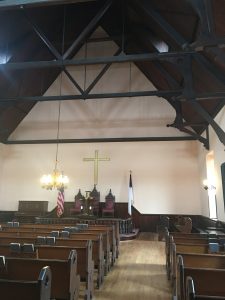
Jessop Meeting House was built in 1809 and named after Revolutionary War Soldier Charles Jessop of Baltimore County.
Charles Jessop was one of the most active of the original trustees in the establishment of the meeting house. He is said to have selected the site, secured the land, was most generous in his donations to the building fund and also supervised the construction of the church. In early life he was said to be the strongest man in Maryland, weighing about three hundred pounds. So widespread was his reputation for strength that people came from all parts of the country to wrestle with him. He was converted to Methodism when a young man, under the ministry of his uncle – one of the first Methodists in America.
Charles Jessop was born in Baltimore County Maryland on November 6, 1759. At about the age of 12, he heard a Methodist man preach and begun a life’s journey in the Methodist Church. At the age of 16 he was bound out as an apprentice in a local millwright business. During the later part of his apprenticeship, Charles was drafted and served in the Army of the United States during the Revolutionary War.
Charles took an active part in all public affairs for the good of the community. His business ventures also met with well deserved success for in starting out in life his capital consisted of only a pair of willing hands, a strong constitution, and a determination to succeed.
Aside from the deed conveying to the trustees, an acre of ground on which to build a Methodist house of worship in 1811, there are no records of the Church. Most likely between 1809 and 1811 the congregation met in the homes of the members, and held services in various places until plans could be formulated and sufficient funds raised to build a church.
On the first day of March, 1811, John Gorsuch, Jr., owner of a tract of land overlooking Jessop Valley, and, in a distance, Cockeysville, ” for the consideration of one dollar, deeded to Charles Jessop, Charles Gorsuch, John Hatton, Phillip Lettig, Robert Fisher, Samuel Willis and John Hatton, trustees in trust; never-the-less to and for the uses and purposes of erecting theron a house or houses for the uses and purposes…for the benefit of the society of Christians, commonly known by the name of the Methodist Episcopal Church of the United States of America.”
Under the strict provisions of this deed the one ace was taken over by the trustees named, and a little later the first house of worship of the congregation of Jessop M. E. Church was erected-the walls of which still stand as the major portion of the present edifice.
Before there was a national anthem, signers of the Declaration of Independence still living, this church stood overlooking the valley. Think of the events that have taken place since the building was first dedicated. The Civil War, Spanish-American War, The Great War, the Second World War! All events touching the lives of the members here. Jessops became part of the Great Falls Circuit with nineteen preaching stations served by a circuit rider.
Jessops Church was enlarged in 1854 and then redesigned in 1887 following a dramatic restyling by renowned architect Benjamin Buck Owens of Baltimore. The original Church was a rectangular, stone structure, about sixty feet in length, forty feet in width; perfectly plain, with low ridged roof; a series of windows along its east and west walls and small entrance doors at the south end. It was heated by stoves and lighted by oil lamps; was comfortable and commodious for the congregation that attended services of worship. The first building seems to have sufficed until 1854, when the remodeled church was opened. The Rev. John H. Dashiell and Rev. Henry Sipes were the pastors. Sometime later the church was closed for a while, but reopened on ay 29th. 1887, by Bishop Andrews who preached the morning sermon. The pulpit was filled in the afternoon by the Rev. A. J. Gill. At the time the Rev. J. H. Lemon and Rev. Samuel Alford were the ministers in charge. The Rev. W. F. Speake was presiding elder.
The congregation of his Church celebrated the Centennial of its founding on December 4, 1909. Today, Jessops Methodist Church is a historical Jewel quietly resting high about the hubbub of commerce by which it is now surrounded. Time has indeed been kind to Jessops, however as is the way with old buildings, repairs and restorations are sometimes needed. The Jessops Board of Trustees continues to undertake the efforts necessary to preserve the beauty of the Church building. Jessops is historical in a number of way including, religion, architecture and local Baltimore County history. We are endeavoring to preserve Jessops’ historic integrity to insure its future preservation.
Historic Jessops Church is now on both the Baltimore County Landmarks list and the Maryland Historical Trust’s inventory of historic places. The beautiful stained glass and etched windows were crafted in 1887 by Gernhardt, a well known artisan of that time period.
